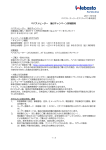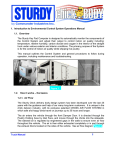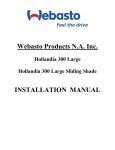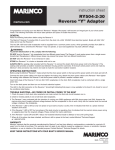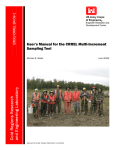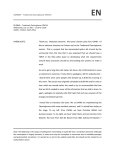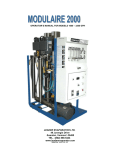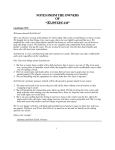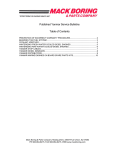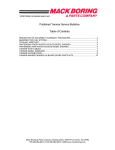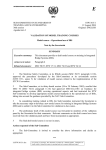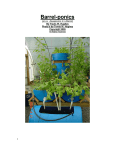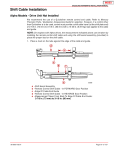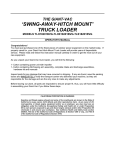Download Pearson 33 Systems and Operating Procedures
Transcript
Fairwinds Sailing and Recreational Society Standard Operating Procedures Jolie Systems Revised: August 2014 1 Document Revision History August, 2014 : fueling, Webasto heater , electrical systems update June, 2013 : pre/post sailing checklists and anchoring procedure updated January 23, 2005 – created 2 JOLIE SYSTEMS ................................................................................................. 1 SKIPPER SIGNATURE SHEET ........................................................................... 6 OVERVIEW .......................................................................................................... 8 ELECTRICAL SYSTEMS ..................................................................................... 8 HOUSE BATTERIES ENGINE STARTING BATTERY BATTERY SELECTOR BATTERY CHARGING 12 VOLT BREAKER PANEL 12 VOLT SYSTEMS NOT WIRED THROUGH A BREAKER 120V BREAKER PANEL SHORE POWER WATER HEATER ELECTRICAL OUTLETS ELECTRIC BILGE PUMP STEREO / CD CHANGER DEPTH, SPEED, LOG AND WATER TEMPERATURE INTERIOR LIGHTING NAVIGATION AND DECK LIGHTING VHF RADIO GPS 8 9 9 10 10 11 11 12 14 14 14 14 15 16 16 16 16 ENGINE / PROPULSION SYSTEMS ................................................................. 17 OVERVIEW STARTING RUNNING STOPPING EMERGENCY STARTING EMERGENCY STOPPING OVERHEATING OIL PRESSURE FAILURE ALTERNATOR FAILURE FUEL ENGINE OIL ENGINE COOLANT (FRESH) COOLING WATER (SEA WATER) TRANSMISSION SHAFT SEAL PROPELLER 17 18 18 18 19 19 19 20 20 21 21 21 21 23 23 23 DOMESTIC SYSTEMS ....................................................................................... 23 ICE BOX FRESH WATER SINKS AND DRAINS HEAD AND HOLDING TANK 23 23 24 24 3 SHOWER GALLEY STOVE PROPANE CABIN HEAT BUNKS AND CUSHIONS 25 26 26 26 27 RIGGING ............................................................................................................ 28 SAILS RUNNING RIGGING DOCKING LINES, FENDERS, ETC. 28 28 28 DECK SYSTEMS................................................................................................ 28 STEERING THROUGH-HULL AND VENT LOCATIONS STORAGE ANCHORING BILGES AND BILGE PUMPS STERN-TIE LINE 28 29 29 30 31 31 SAFETY AND MISCELLANEOUS ..................................................................... 32 FLARES LIFE VESTS – PFDS – FLOATING THINGS FIRE EXTINGUISHERS TOOLS AND SPARE PARTS LIGHTENING PROTECTION REVERSE POLARITY LIGHT PROPANE ALARM ENGINE PANEL ALARMS DOCUMENTATION, LOG AND OPERATING MANUALS DEHUMIDIFYING AND WINTER STORAGE THE BAR MISCELLANEOUS BOAT EQUIPMENT CLEANING SUPPLIES AND EQUIPMENT BARBEQUE LOCKS AND KEYS 32 32 32 33 33 33 33 34 34 34 35 36 36 36 36 PRE-SAILING CHECKLIST ............................................................................... 37 POST SAILING CHECKLIST ............................................................................. 39 4 Skipper Signature Sheet All skippers must sign below to indicate that they have read the complete “Jolie SOP” and relevant section in the “Manual Book” Skippers must also read the Pearson Owner’s Manual. Name Date Signature 5 Overview Boat Type: Hull Number: Hull Id. Number: Length Beam: Height: 47’ 6” Draft: Displacement: Ballast: Sail Area: Hull Speed: Fuel Capacity: Potable Water: Aft Tank: V-berth Tank: Hot Water: Engine: Fuel consumption Holding Tank: Rudder: VHF 1988 Pearson 33-2 140 PEA88I40F788 LOA: 32’ 6” 11’ 0” LWL: 26’ 3” 5’ 11” (fin keel) 12,441 lbs 4,000 lbs 515 sq ft. 6.9 kts 18.5 US gal or 70 liters 20 US gal (75 liters) 24 US gal (90 liters) 6 US gal (22 liters) Yanmar 2GM20F 18hp at 3600rpm 2.4 liter/hour @ 2800 rpm 14.5 US gal Spade call sign: CFN6073; MMSI#: 316022134 Electrical Systems Batteries House Batteries (Number 2 on selector) located under after berth (2 x 6V/240Ah batteries in series) Engine Starting Battery (Number 1 on selector) located in the lazarette. To be used for starting engine only. Battery Selector Location: The selector switch is located in after cabin. Warning: NEVER turn the battery selector through the “OFF” position while the engine is running. If the “OFF” position is selected while the engine is running, the alternator diodes may be seriously damaged. Switch battery selector through the “BOTH” position to select batteries. 6 Use: To start the engine when leaving dock, select battery #1 (Starting battery). Once the engine has started, select battery #2 (house batteries), by turning the selector through the “BOTH” position and leave it there for the duration of your voyage. The engine may be started from the house batteries without detrimental effect to them, but using the starting battery at least once per trip will lengthen the life of the starting battery. After Use: Battery selector switch must be turned to the “OFF” position when finished using boat. Battery Charging Location: There is a permanent, “smart” ferro-resonant charger located under the aft berth. The breaker for the charger is located on the shore power portion of the breaker panel. This system may only be used when connected to shore power. The charger is designed to not overcharge the batteries, so the 110v charger breaker should be left in the ON position when connected to shore power. Jolie is equipped with a digital battery separator that charges both batteries while the engine is running. Use: The built-in battery charger may be used at any time while connected to shore power. If running the engine only to charge the batteries, do not idle the engine, run at about 1200 to 1500 rpm to ensure proper lubrication. After Use: If connected to shore power leave the charger breaker in the ON position. When not connected to shore power the breaker should be in the OFF position. Check electrolyte levels in “House” batteries regularly and top up with distilled water when needed. Breaker Panels / Power Distribution The following is a list of equipment that is isolated by each breaker. 12 Volt Breaker Panel Breaker Name Cabin Lights Running Lights Anchor Light Nav / Com Instruments Sump Pump / Water Pressure Stereo Head Discharge Spreader Propane Systems Controlled All interior lights Running lights (sail and steaming light) Anchor light (LED) VHF Cockpit instrument cluster Shower / head sump pump (On/Off switch is in the head) Turns on water pressure system (NEVER USE if the water tanks are empty) Stereo & CD changer Operates holding tank pump Spreader lights (shines on foredeck) Operates propane electric shut-off valve 7 Other 12 V breakers: Electric windlass Electric head Webasto heater fuse Aft cabin In the head, next to “holding tank full” light Lazarette under the heater 12 Volt Systems not wired through a Breaker - Auxiliary 12 Volt plug-in (cigarette lighter type). - Bilge pump (pump operated by switch above breaker panel and will operate even when battery selector is in OFF position). - Clock on Webasto controller /timer (will run with battery selector in OFF position). - Propane alarm /CO detector (will NOT operate with battery selector in OFF position). - Battery status monitor 120V Breaker Panel Breaker Name Main Breaker Reverse Polarity Light Outlets Appliances / Water Heater Accessories / Battery Charger Systems Controlled Turns shore power on to the rest of the panel Light turns on if polarity reversed Electrical outlets Turns on the water heater Turns on the built-in battery charger. Electrical systems power budget DEVICE Power draw Windlass 35A (420W) Electric head 18A (200W) Head discharge 16A (190W) Webasto heater 8 A (90W) 3.2A (40W) 1.2A (15W) Water pressure pump 4.0A (48W) Running lights 1.7A (20W) sail 2.5A (30W) power Propane solenoid 1A (12W) Stereo 1A (12W) Cabin lights 1.4A(16W) Anchor light Nav/Com Instruments 0.2A (2.5W) 0.5A (6W) 0.2A (2.5W) 8 Notes use it ONLY while the engine is running high amperage, but only minutes per day in use. use it while the engine is running - glow plug pre-heating (initial ~20 seconds) - first stage heat - temperature maintenance mode (low speed fan). while the pump is running w/ all white lights ON. Note: white cabin lights are a LED ty Red incandescent lights draw 1Amp each. Individual Electrical Systems Shore Power Jolie has a 120V - 30 Amp system (round plug). A gender-bender is required to connect to 15 Amp shore power. Connector Location: The shore power connector is located under the helmsman’s seat (aft cockpit port side). Shore power breakers: The forward section of the breaker panel is for shore power systems. These include electrical outlets, the water heater and battery charger. Cable: The shore power cable is kept in a canvas bag in the lazarette. Also in the bag are: gender-bender fittings, Velcro tabs for supporting the cable and a rubber bungee for supporting the cable at the jetty power source. Always store the cable on board, never leave it on the jetty. When connecting to shore power, always “work towards the source”. This means connect the boat end first, secure the cable run and finally connect to the shore power source. Always make this connection last so the cable is never live until it is all set-up. After Use: When finished with Jolie, leave her connected to shore power at Tsehum Harbour. 9 Water Heater Location / Specifications: Six gallon hot water tank is located under the holding tank, accessed from the lazarette. Water is heated by 120V (shore power) electric heater element and also by engine heat. The breaker is located on the shore power breaker panel. Use: Hot water may be turned on whenever connected to shore power. Warning: Do not turn on the water heater breaker when the tanks are empty. The heater must be full of water before 110v power is applied in order to avoid damage to the heater element. You can confirm there is water in the system by turning on any tap while system is pressurized. In addition to the shore power water heater, the water also automatically heats whenever the engine is running. After Use: Turn off hot water breaker. Electrical outlets Location: Electrical outlets are located throughout the cabin. Use: Outlets may only be used when connected to shore power. To use, turn on the outlet breaker on the shore power breaker panel. The outlets in the galley and head are groundfault protected. After Use: Turn off the outlets at the shore power breaker panel. Electric Bilge Pump Location / Specifications: The electric bilge pump is located under the deck panel, amidships, next to the liquor cabinet. It has a single pick-up located amidships, about ½ inch from the bilge bottom. Operating switch is on the instrument panel. Flow rate is: 800 gph Automatic operation: Leave the switch in the Automatic position. The automatic bilge pump runs directly from the battery. Manual operation: Select Manual on bilge pump selector switch. Switch back to Automatic when the pump loses suction. Stereo / CD changer Location / Specifications: Stereo and CD changer are located port side in the cabin. Speakers are located in the cabin and in the cockpit. Fader control may be used to select between these. Use: Refer to manual for operation. Stereo breaker must be on. After Use: The CD cassette must be left in the CD changer after use. The remote control must be left on its Velcro tab after use. Depth, Speed, Log and Water Temperature Location / Specifications: Sensors are located in the forward bilge compartment. The instrument displays are located on the binnacle. Use: Turn on the instrument breaker on the breaker panel. After Use: Turn off the instruments breaker. 10 Interior Lighting Location / Specifications: Located throughout cabin. All interior lights operate on 12V. Use: Lighting breaker must be on. Dome lights may be switched to either white (LED) or red (incandescent) light. After Use: Turn off all lighting and the breaker. Navigation and Deck Lighting Location / Specifications: Controlled from navigation light control panel and main breaker panel. Use: The navigation light control panel shows various light configurations. Configurations are running lights (sail and motor) anchor light and foredeck light. After Use: Turn off all lights and shut off breaker. VHF Radio Location / Specifications: Instrument panel / Standard Horizon Quest-plus, DSC. Use: Refer to owners manual. Command Mic. is stored on the shelf port side; it is to be connected to connection in cockpit. After Use: Place Command Mic. on the port shelf, turn off Nav/Com breaker. GPS Location / Specifications: GARMIN hand-held type, on holder, port side, forward of the nav station Use: Use plug-in connected to the GPS unit, as the device feeds GPS coordinates to VHF Radio. After Use: Turn off GPS unit. Battery status monitor Location / Specifications: Instrument panel / Battery voltage and charging systems monitor. Use: "Three bars" (or 12.6V) is a "battery fully charged" indicator. That normally relatively quickly falls to 12.3V (2 bars) under a load and then slowly slips to 2 bars (12V) over time. Once a single bar begins tp flash (<12V), it is time to recharge the battery (ie. run the engine for an hour @ 1200 rpm or engage the battery charger, if on shore power). The battery monitor draws a negligible current and it should be left ON at all times. Engine / Propulsion Systems Engine Overview Engine Type: Horsepower: Yanmar 2GMF-20 18hp @ 3600rpm 11 Basic Description: output:75Amps. Hour-meter: Price: 2 Cylinder, Freshwater Cooled, Diesel Engine. Alternator Located above breaker panel Pay the hourly rate to the kitty located in the navigation table. ($8.00 per hour at time of publication of this SOP – refer to website for current rates) 12 Starting 1. Check oil. Dip stick is accessed via small door in aft cabin. Engine room light switch is below the battery selector switch (cabin lights breaker must be on to operate light). If low -top up with 15W-40 engine oil. Spare oil is stored under port settee. 2. Check cooling water level (Check only when cold). 3. Check cooling water through-hull (normally left open) in main engine compartment. 4. Visual check. Check for obvious leaks of oil, fuel or cooling water, check alternator and water pump belt tension, check for loose hose clamps, broken components. When replacing companionway steps, ensure the bottom of the step is properly seated. 5. Check fuel level. Fuel tank gauge in the aft berth. 6. Place gear selector in neutral. 8. Turn on ignition and press start button. 9. Engine should turn over. Release the button as soon as engine fires steadily. NOTE: Do not crank engine for more than 15 seconds. If engine fails to start, wait 15 seconds and try again. NEVER press the start button unless the engine is fully stopped. 11. Warm-up engine for a minute or two at high idle (~1200 rpm) – long enough to ensure it is running smoothly; extended warm-up dockside is not necessary as diesels don’t warm up well under no load. VISUALLY CHECK that water is being ejected out the exhaust pipe. This indicates correct cooling water flow. Running 1. Select desired gear (forward – down, back – up). Always ensure engine is at idle before changing gear. 2. The engine is rated for 3600 max rpm. It runs most comfortably at about 2800 rpm. Running the engine between 2800 and 3000 rpm while cruising will keep it “hot” and it will prevent build up of undesirable carbon deposits in the system. 3. Maintain a watch on engine’s rpm, listen for unusual noises, monitor engine exhaust colour, and visually inspect quantity of water in exhaust on a continual basis. Shut engine down if there is anything out of the ordinary. 4. The most common cause of overheating is seaweed stuck in the cooling water inlet. If overheating occurs… shut off engine, close engine water through-hull valve and clean water strainer (near the valve). Replace strainer, open valve and try engine again. Stopping 1. Place throttle at idle. Allow engine to operate at a low speed for about five minutes to cool. If engine has been used at low speed for this amount of time to moor the boat… this will suffice. 2. Ensure gear box is in neutral. 3. Move throttle to ¾ position and allow engine to rev for about 2 seconds. 4. Move throttle to idle and pull stop lever while engine is coming down from the high revs so that it slows and stops in one smooth motion. (this procedure will help clear carbon from the cylinders before shutting off) 5. Switch off the ignition. 13 Emergency Starting The engine will not start if both “Starting” and “House” batteries are drained. Avoid putting the battery selector switch on “BOTH” position. Emergency Stopping 1. In the case of an emergency, pull and hold the stop lever until the engine stops. 2. If the stop lever does not work, pull the stop lever mechanism on the engine. 3. If the engine still won’t stop, close the fuel shut-off valve (on the fuel tank under aft berth). Fuel lines will need to be bled to re-start. 4. As a last resort (in case of engine run-away) pull the decompression lever until the engine is stopped. If you use this method, fuel delivery to the engine continues until the engine stops turning. This will result in abnormal combustion, and possibly explosion, when the engine is next started. Engine Emergencies The engine alarm panel has audible and visual alarms for high water temperature (Overheating), low oil pressure and low charging voltage (Alternator Failure). The following actions should be carried out if the alarms sound. Overheating If engine overheats, STOP ENGINE IMMEDIATELY. The most likely cause is a sea water blockage. Clean strainer /raw water inlet and try again. Oil Pressure Failure In case of oil pressure failure, STOP ENGINE IMMEDIATELY. Check oil level and replenish if required. If oil level is ok, do not re-start engine. If oil level is low, (it will have to be very low to cause a loss of oil pressure) then check for leaks prior to restarting. Alternator Failure If the alternator fails, you may keep running the engine. The batteries however will not be charging during operation, and the problem should be rectified as soon as possible. 14 Engine Systems Fuel Location / Specifications: -Aluminum tank, located under aft berth (70 liters, 18.5 US gal). -Fuel gauge is located under aft berth on top of the tank. -Fuel shut-off valve is located on the top forward edge of the fuel tank, accessed under the aft berth. -Deck fitting: located at the aft port corner of the deck. Use: Fill with diesel fuel only to max. 7/8 of tank's capacity. Do not overfill to minimize the risk of a diesel leak from the tank. Fuel consumption is about 2.4 liters per hour at 2800 rpm. Feel free to calculate it for a long trip and let the boat captain know what your consumption is. The range of Jolie on a full tank is about 30 hours or about 180 nautical miles. NOTE: The fuel gauge will not display the diesel levels below ~1/4 full. Do not run out of fuel or you will have the joy of priming the fuel system when you fill it next. After Use: No action required. Engine Oil Location / Specifications: Filled though cap on top of engine rocker cover. Oil is stored under the aft berth on the starboard side. Use: Use 15W-40 only, check oil level once per day during engine use. After Use: Clean all spilled oil as if the engine compartment is your kitchen. Engine Coolant (Fresh) Location / Specifications: Engine coolant may be checked via the expansion tank, located in the upper port side of the engine compartment. This is accessed from the aft cabin (under the forward shelf). Use: May be topped up with fresh water or anti-freeze coolant. Inform boat captain if it is necessary to frequently top up engine coolant. After Use: Clean any spills as if the engine compartment is your dining room. Cooling Water (Sea Water) Location / Specifications: Through-hull valve is located in the engine compartment, under the companionway on the starboard side. The strainer is located just above the through-hull valve. Use: The through hull should be left open at all times. A visual check should be carried out prior to boat use. The strainer should be checked / cleaned if a cooling problem arises. A loss of cooling water flow may be indicated by a lack of water flowing from the exhaust, or the sound of the exhaust changing to a loud, throaty roar. Running the engine with no cooling water in circulation will damage the raw water impeller after a few minutes and it will ultimately cause serious engine damage. After Use: No action required. 15 Other Propulsion Systems Transmission Location / Specifications: The transmission should not require any maintenance by boat skippers. Use SAE 30 oil in the transmission only. Shaft Seal Location / Specifications: Located under aft berth. There is a dripless, permanent PSS stuffing box fitted. Propeller Specifications: Two blade right-hand prop. Walks to port when going astern. Domestic Systems Ice Box Location: The ice box is located under the chart table. The drain is the hand pump located in the head sink. Use: It is recommended that the ice box be pre-cooled prior to use (by placing a block of ice in the cooler approx. 12 hours prior to use). Storing food in such a way as to minimize the amount of times the ice box is opened will maximize the life of a block of cooling ice. After use: Always do the following: empty, pump out, wash, place some fresh water in the ice box and pump-out again then wipe dry. Leave the lid open to allow the ice box to dry completely. Fresh Water Location / Capacity: There are two fresh water tanks. The forward tank (24gal) is under the v-berth, the after tank (20gal) is under the starboard settee. The hot water tank (6gal) is located in the lazarette, under the holding tank. The pressure pump and valves are located under the starboard settee. Deck Fittings: There are two deck fittings, one at the bow for filling the forward tank and one starboard side aft of the shrouds for the filling the after tank. Do not overfill tanks (only fill to within 2" of top) as they will leak out vents/inspection covers into the bilge and under the galley. Use: Pump must be turned on at breaker panel. Normal use is to use forward tank only and reserve aft tank for back-up if you empty the forward tank. If you are going to fill both tanks at the end of your cruise, you may use either tank (selector valves are under the after settee). Select only one tank at a time, do not open both tank valves at the same time (this will connect both tanks together and they will attempt to equalize levels). Warning: Only turn on water pressure pump when it is required, and NEVER if the tanks are empty. Warning: When one tank is empty, always shut off the empty tank and select a full one. 16 After Use: Always ensure the after tank is full and the forward tank is selected for use. If you empty the forward tank… fill it too. Sinks and Drains Location / Specifications: There are two sinks… galley and head. Each supplied with hot and cold pressurized water. Use: Through-hull valves for drains must be opened for use. One is located under each of the sinks. Close the head sink drain when sailing. On a port tack, the head sink can fill with water, and it will slosh about and make a mess. After Use: Close through-hull valves . Head and Holding Tank Location / Specifications: 14.5 gallon holding tank located forward part of lazarette. Macerator pump, the Y-valve and “odor control” vent-line carbon filter are located above the tank. Head inlet through-hull is located in forward port corner of engine compartment. Tank full light (red) located in head on port bulkhead. Overboard pumpout through-hull valve is located in the bottom of the lazarette. Head Use: Jolie is equipped with electric macerating head. The rule of thumb is: if you didn’t eat it, it shouldn’t enter the head, with the exception of a small amount of Marine grade toilet paper. Pre-flush if you are doing a number 2 to wet the bowl. The Y-valve selects either overboard flush or flush to holding tank. Do not flush to holding tank if the red “holding tank full” light is on. Hold the FLUSH button down for 8 seconds to ensure your deposit is flushed though the system to the tank or over the side. To Pump Holding Tank Overboard: Ensure discharge through-hull valve is open (it is normally left open). Turn on the pump at the breaker and run pump until the tank is empty. It takes about a minute to empty full tank. To use Vacuum Deck Discharge: Connect vacuum hose to deck fitting and empty tank. There are no valves to open. After Use: Close head inlet through-hull valve. Ensure Y-valve is in the overboard position. Leave the overboard pump-out through-hull in the open position. Fill the tank with fresh water and add H/T enzymes to prevent build-up of hard deposits in the system. Shower Location / Specifications: Shower is located in the head. Use: Ensure shower curtain is up. Turn water pressure breaker to the ON position. While showering, turn ON the sump pump switch (in the head) and turn it OFF immediately after your shower. (remember… showering uses up your water supply). To make water come out of the shower head, open the valve between the faucet controls and the showerhead. After Use: Ensure shower area and curtain are dry and sump has been pumped dry. 17 Galley Stove Location / Specifications: Gimbaled two burner propane stove with oven. Fiddles are stored in bottom of galley drawer. Use: Refer to owners manual for proper operation. Also, see section below about propane use. After Use: Shut off propane and clean the oven as if you are about to eat off it. Propane Location / Specifications: Propane tank is located in the propane locker, aft – port side of cockpit. System has a solenoid shut-off valve. Note: the propane alarm is not interconnected with the solenoid. If the alarm sounds, shut off the propane breaker immediately. To test the operation of the alarm, press the test button… the light should come on immediately and the audible alarm will sound after holding the button down for 15 to 20 seconds. Use: To use, tank valve must be manually opened. Solenoid valve must be opened by turning on at breaker panel. Propane is now ready to be used (stove only). Tank valve may be left open while cruising, but solenoid should be shut at all times when propane is not in use. If propane is sensed by the detector, the alarm light will come on immediately and the audible alarm will sound after propane has been sensed for 15 to 20 seconds. When finished using the stove, shut solenoid valve by shutting off the propane breaker and allow the flame to extinguish on its own (uses the propane in the line) then close the control valve on the stove. After Use: Close the tank valve before retiring for the night, and at the end of your cruise. Fill the tank if you emptied it. Cabin Heat Location / Specifications: Webasto EVO3900 diesel heater is located in the lazarette. Heat outlets are located in head, aft cabin and main cabin. Webasto programmable controller is located on the breakers panel. The heater’s fuel shut-off valve and the fuel pump are located in the aft cabin by the fuel tank. Use: To use, set the temperature dial and push “Heat” button on the controller (refer to user manual for details, please). Do not block the heater outlets. After Use: Turn off heater. Warning: Serious damage to the heater may occur if power is switched off while the unit is in operation. Wait at least 2 minutes before switching battery selector to “OFF” to ensure that the heater has a cooling down period. Note: in off-seasons months - run the heater 20 minutes once a month to maintain the fuel line prime and keep the fuel pump lubricated. Bunks and Cushions Location / Specifications: Located throughout the boat. Use: Use as desired, keep dry. After Use: Place cushions on their side to promote air circulation. 18 Rigging Sails Location / Specifications: Main and roller-furled genoa only. Two reefing points on main, single reefing point on genoa. Use: Use proper seamanship. Note that genoa reefing point is indicated with a vertical line on the foot of the genoa. After Use: Furl sails, secure all lines and place cover on the main. Running Rigging Location / Specifications: All led back to cockpit except topping lift and outhaul. There is a spare halyard rigged on the port side of the mast. Use: Use proper seamanship. After Use: Coil and stow all lines on their hangers. Docking Lines, Fenders, etc. Location / Specifications: Dock lines and fenders are located in the lazarette. Life lines on port side open for easy access to dock. Use: Use as appropriate. After Use: Coil and stow all lines, close lifelines. Deck Systems Steering Location / Specifications: There are two fitted steering systems. The “destroyer wheel” on the cockpit binnacle and the emergency tiller system. The emergency tiller is kept in the lazarette, the rudder post fitting is located under a white, round cover under the helmsman’s seat. Use: Use as per manuals. Steering lock is located on starboard side of the pedestal. Do not over tighten. After Use: Leave steering unlocked and cover the binnacle with the canvas cover. Through-Hull and Vent locations Location / Specifications: It is important that skippers are aware of where the hull is penetrated, as these are potential locations for major leaks. Also, care must be taken not to damage these if the boat is hauled out of the water. Locations are shown in figure 7.1 in the Pearson 33 Owners Manual. The following is a list of the through-hull penetrations near or below the waterline: 1. Engine raw water intake 2. Head intake 3. Head overboard discharge 19 4. 5. 6. 7. 8. 9. Bilge discharge Sump discharge Galley sink drain Head-sink drain Propane bin drain Deck drains There are also vents and drains above the waterline… they are: 1. Propane bin vent 2. Cockpit drains 3. Engine exhaust 4. Fuel tank vent 5. Holding tank vent 6. Anchor locker drain Finally, just forward of the keel are the instrument heads (knotmeter (wheel type), depth sounder, water temperature). These are accessed from the bilge, under the table. Most through-hulls have a wooden plug for emergency use, located on a sting, near the hull penetration. Storage Location / Specifications: There is dry storage located throughout the boat. All skippers should be familiar with the location of all storage. After Use: Empty and clean all storage compartments you use as if you are going to eat out of them. Anchoring Ensure crew are familiar with windlass and anchoring procedures; it will save on windlass repair costs. IN AN EMERGENCY USE THE WRENCH TO RELEASE THE CLUTCH TO DROP THE ANCHOR. Lowering the anchor 1. Confirm that the power to the windlass is turned on (switch in aft cabin). This switch should ALWAYS be on when underway. 2. Unhook the chain from the deck lock and release a foot or so of chain. 3. Push the anchor outboard until it will fall on its own. 4. Wait for a signal from the helmsperson to lower the anchor. 5. Let out enough chain for the anchor to reach the bottom. The boat should not be drifting backwards as you do this. 6. Signal to the helmsperson to go astern as you pay out more chain. 20 7. Watch the marks on the chain and pay out the correct amount of chain. You are responsible for determining the correct scope. 8. Signal the helmsperson to stop the boat. 9. Place the chain hook (in chain locker) on the anchor chain. 10. Let out a bit of slack on the chain so that the anchor is now pulling on the chain hook and rope and not the windlass. 11. Signal the helmsperson to set the anchor by GENTLY going astern. 12. Reach overboard; place your hand on the chain so that you can feel when the anchor stops dragging. 13. Once Jolie comes to a stop (judging by the shore) speed up the engine to drive the anchor through any weed and into the bottom. 14. If you are spending the night, remove the chain hook and replace it with the bridle. 15. Ensure there is slack between the bridle and the windlass. Raising the anchor 1. Power Jolie slowly towards the anchor as you retrieve the chain with the windlass. Do not overload the windlass towing the boat into the wind. 2. When Jolie is over the anchor (chain is close to vertical) slip the chain hook onto the chain and release a bit of chain (as you did lowering the anchor) so that the pull is on the chain hook and rope, and not the windlass. 3. Signal the helmsperson to GENTLY power ahead and watch for the anchor to break free of the bottom. DO NOT BE IN A RUSH. It can take a few minutes for the anchor to ooze out of a muddy bottom. 4. Remove the chain hook. 5. Raise the anchor watching the chain coming aboard. If it is muddy, get the boat brush and clean it before it gets on the deck and into the chain locker. 6. When the anchor gets close to the roller, reach out and pull it over the top and onto the deck. 7. DO NOT GET UNDERWAY BEFORE THE ANCHOR IS ON THE DECK. The anchor can swing and crunch the hull if it is hanging off the bow. 8. Secure the anchor with the deck lock. 9. Signal the helmsperson that they can 'get underway'. Bilges and Bilge Pumps Location / Specifications: The bilges are shallow so please keep them as dry as possible to avoid damaging the wooden floor. They are accessed via removable deck plates throughout the cabin. There are three bilge pumps. One electric 800gph (located in bilge next to liquor cabinet), one permanently mounted hand pump 500 gph (suction located in bilge next to liquor cabinet, operated by hand-pump on cockpit on the port side) and a 21 portable hand-pump kept in the lazarette. The manual bilge pump handle is stored under the helmsman’s seat. Use: Follow directions in manuals. After Use: No action. Stern-tie Line Location / Specifications: There is 200 ft of floating stern-tie line in a bag on the aft pushpit. Safety and Miscellaneous Emergency Equipment Flares Location / Specifications: Coastguard approved complement of flares are located above the settee on the starboard side. Use: In case of emergency, use according to instructions. After Use: Record in log and inform boat captain of use so flares can be replaced. Life Vests – PFDs – Floating things Location / Specifications: There are four adult PFDs. They are stored in the hanging locker in the aft cabin. There are four boat-cushion / throwing-devices kept under the vee-berth. There is one life-sling attached to the pushpit rail. Use: Follow coastguard approved directions for the use of each device. The square throwing cushions may be used for cockpit cushions while underway. A fender should be used to practice man-overboard drills… tie a loop in the fender line for easier retrieval with a boat hook. After Use: Return all items to their storage place after use. Fire Extinguishers Location / Specifications: There are three – 3lb dry chemical ABC fire extinguishers. 10. Under the helmsman’s bench 11. V-berth 12. Galley Use: All skippers must read the directions on the side of the extinguishers. To use, pull pin, point at base of flame from a couple of feet away, squeeze lever. After Boat Use: No Action Tools and Spare Parts 22 Location / Specifications: Tools and spare parts are located in tool boxes in the forward cabin. Use: If spare parts are used from the tool boxes, let the boat captain know. Ensure tool boxes are secure, prior to sailing. After Use: Dry off and clean the tools before replacing in the tool box. Lightening Protection Location / Specifications: Jolie is fitted with a lightening protection system. This system provides a cone of protection around the boat during an electrical storm. A bonding system of #8 gauge stranded copper wire connects the chainplates, mast step, fuel fill and fuel tank to the keel. Use: In the case of an electrical storm, do not allow anyone in the water. Everyone on board must stay inside the boat. Do not make contact with any metal object, regardless if it is connected to the bonding system or not, especially in such a manner as to bridge any of the bonded items listed above. After Use: In the case of a lightning strike, damage to electronic equipment is likely. All electronic equipment must be tested for proper operation and calibration. Contact boat captain in case of a lightning strike. Safety Alarms and Warnings Reverse Polarity Light Location / Specifications: Warning light located on 120 Volt shore power breaker panel Use: If this light is on, turn off the 120 Volt shore breaker immediately, disconnect the power cable from the shore power connection and inform the marina management. Do not use reverse polarity power, it can kill you. After Boat Use: No Action Propane Alarm & CO detector Location / Specifications: • There is one propane sniffer (red thing) located at foot level below the chart table. Be careful not to bump it as it will be your responsibility to replace this expensive part if it is broken. The alarm monitor is located on the breaker panel. Use: The alarm should be turned on and tested each day. Test by pressing the test button and holding for 20 to 30 seconds. The red light should come on immediately, and the alarm should sound after about 20 to 25 seconds. Leave alarm turned on at all times that a propane tank is on board. This alarm is not connected to the propane valve. If alarm sounds, extinguish all flames and shut off propane valve immediately. Evacuate the cabin, shut of tank valve and open hatches to air out the cabin. • There is one maintenance free CO detector located on the port side bulkhead. After Use: No action required. Engine Panel Alarms 23 Location / Specifications: The engine operating panel has light and audible alarms for high water temperature, low oil pressure and low charging voltage. Use: Stop engine immediately and investigate problem if alarm sounds. See section on engine emergencies for corrective action. Miscellaneous Documentation, Log and Operating Manuals Location / Specifications: The operating manuals for all equipment are located in a binder situated on the starboard side above the settees. The Pearson 33 Owner’s Manual and the Yanmar owner’s manual are also located here. The log book, charts and other paperwork are located in the chart table. Use: All skippers should familiarize themselves with the operating procedures for every piece of equipment on board. After Use: Return to proper stowage locations. Dehumidifying and Winter Storage Location / Specifications: During cooler months, an electric heater and a blower will be placed on board by the boat captains. Use: During winter months, while the boat is not in use, both the heater and blower should be plugged in and left running to minimize moisture. The heater should be left on its low heat setting. After Use: Carefully stow the heater and blower while sailing. The Bar Location: Liquor cabinet is located on the port side of the galley. Use: Instructions are in the liquor cabinet in a little note book. Use the 1 oz measure located in the cabinet to measure your drinks. Keep a record of how much you drink in the note book (tear out when done) and pay the posted rate per drink to the bar kitty located in the cabinet. Replenish any depleted stocks from the bar kitty. Keep bottle receipts in the kitty. Warning: If you sail to the US… on your return, Canada Customs has the right to charge a skipper duty on all alcohol onboard (over your duty-free limit) unless it is in an unopened (sealed) bottle and you have a Canadian receipt for it. If they do this, it is only on the actual amount of liquor in the bottles. Generally they will not bother to do this as thousands of boats travel to and from the US with stocked bars every year; however, they can, and occasionally do, exercise their right to check your bar and charge duty. If you do not wish to be subject to this possibility, drink what you take or remove the booze prior to sailing. When asked by Customs what you are bringing into Canada, tell them what you bought… don’t flap your gums about the bar… they never ask if you are bringing back open booze that you purchased in Canada before you left so there is no need to mention it. 24 Miscellaneous Boat Equipment There is various equipment located throughout the boat. Location / Specifications: Flashlights: One in the aft cabin, one on port shelf above settee. Hand held wind speed indicator: Port shelf above settee. Winch Handles - locking type (2): Port shelf above settee (use these ones). Winch Handles – non-locking type (1): Port shelf above settee. 12 Volt portable spot light: Port shelf above settee. 12 Volt, 2 amp portable trickle charger under settee. Hand bearing compass: Port shelf above settee. Spare parts box: Under settee stbd side. Tool Box: Under settee port side. Batteries: Port shelf above settee (if you use them up, replace them or let boat captain know). Wooden through-hull plugs: Port shelf above settee. Companionway door (three pieces): Stored in canvas hanging bag in aft cabin. Use: All skippers should familiarize themselves with the locations and proper use of all items. After Use: Carefully stow any items used. Cleaning Supplies and Equipment Location / Specifications: Cleaning supplies are located in a green container under the galley sink. Use: Use as required. After Use: Replace or inform boat captain of any required replenishments. Barbeque Location / Specifications: Propane barbeque located aft port cockpit mounted on the pushpit. This barbeque uses disposable screw-in propane canisters. The regulator fitting (and a spare) are located in the bottom drawer in the galley. Use: Follow instructions in manual book. After Use: Clean and replace cover. Locks and keys Location: All locks and keys are to be kept in the nav. table when not in use. 25 Pre-sailing Checklist This checklist is intended to be a guide only. Skippers are responsible for all systems on board. Non-inclusion in this list is not an excuse for improper system or boat use. Skippers should file a cruise plan and keep someone updated as their plans change. 1. 2. 3. 4. 5. 6. 7. Read recent logbook AND maintenance log entries. Engine compartment: • Ensure engine water through hull valve is open. • Open Head through hull valve. • Check engine belt tension. • Check engine fresh water coolant level in expansion tank. • Visually check engine. • Check engine oil level if in doubt. You are responsible to make sure it is correct. Check fuel level. Close sink through hull valve in Head. Breakers/Power: • Disconnect shore power from dock then from the boat. • Disconnect the zinc from the chainplate and secure it to the dock. • Switch off shore power breaker. • Turn battery switch to Battery 1 (Start) for starting the engine. • Switch on battery breakers for Nav/Com, Instruments, cabin lights and any others needed. • Turn ON windlass On/Off switch in aft cabin (so windlass is ready in case of emergency) Safety/Equipment: • Confirm the propane switch on the instrument panel is off. Open the valve on the propane tank if you intend on using the stove. • Check safety equipment. • Check carbon monoxide alarm and separate propane alarm are working • Stowage of equipment: ensure everything is secure. Prepare to Sail: • Unlock wheel. 26 Prepare sail covers, raise flag, take out winch handles to cockpit. • Hook-up radio mike, GPS to Binnacle power. Check sounder is functioning. • Check bilge. Empty all water so that it does not slosh onto the cabin sole. • Ensure bilge pump is on auto. • Brief crew/passengers on conduct, safety equipment/procedures and appropriate use of head. i.e., Always sit down when using the head (both men and women). Ensure at least one crew member is familiar with anchoring procedures. • Fresh water: check level if cruising. • Close four cabin top hinged hatches to prevent the jib sheets from snagging, and allow the use of the mainsheet traveller. 8. Start engine. Check that water is pumping out of exhaust. If the exhaust water is week, clean the raw water intake strainer. 9. Warm-up the engine for a few minutes. 10. Switch battery through “Both” to “House” once underway or when you reach your destination. • 27 Post Sailing Checklist This checklist is intended to be a guide only. Skippers are responsible for all systems on board. Non-inclusion in this list is not an excuse for improper system or boat use. 1. Top up fuel, propane and water if needed for the next Skipper. 2. Breakers/Power: • • • • • • • • • 3. Packing up: • • • • • • • • • • 4. Shore power: Connect and secure power-line to stanchions and dock post. Connect at boat first then dock last. (if battery is low or Jolie is expected to sit idle for an extended time) Hang zinc bar and connect to chain plate. Breakers: Turn off all Battery Breakers at the instrument panel. Ensure propane is shut off at the tank. Turn on shore power breaker, outlets and battery charger (if needed). Ensure bilge pump is on Auto. Ensure furnace is OFF. Shut off windlass On/Off switch in aft cabin. Turn battery selector to the OFF position Stow flag, winch handles and radio mike. Stow cockpit cushions. Lock wheel. Install Binnacle and main sail canvas covers. Open skylights in head and aft cabin. Close all other hatches/ports. Remove any personal gear that you brought aboard. Lock lazarette and place engine key in nav. table. Enter details of trip in Log (and maintenance book if there is an issue). If maintenance is required, please either do the work or make arrangements to have it done. Do NOT leave things undone for the next skipper to discover on their way out to cruise. Notify the boat captain of any work done. Enter the current engine hours in the Log book and pay kitty $8.00/hour of engine run time. Cabin interior check: • Close sink valve under sink in Head. 28 • • • • • 5. Close head through hull in engine compartment. Visually check engine (leaks, etc.) Clean the cooler and leave open to ventilate. Open the head door and secure the latch. Plug in the heater during the off season. Turn the heater to low (not lowest) setting and place on cabin sole. Clean and tidy boat. Exterior clean up and check: • • • • Check mooring lines. Check that the three Bumpers at dock side are low and the bumper on the port side is at the gunnel and all are securely tied. Flush chain locker with fresh water. Hose off deck and cockpit. If you know who’s taking the boat out next, be thoughtful and brief them on boat status (fuel, maintenance, etc). 29





























